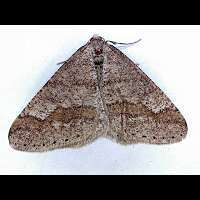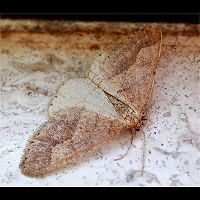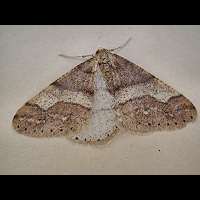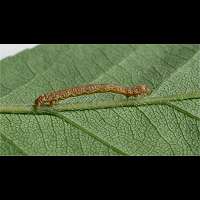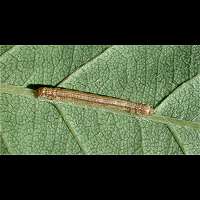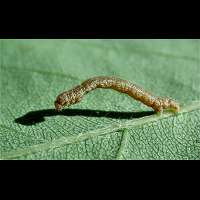Dotted Border (Agriopis marginaria)
Usually the Dotted Border is easily identified: a yellowisg redbrown to sometimes greyish moth with a clear band at about 3/4 of the wing and a row of dots near (but not on!) the edge of the wing. Melanism occurs however and blackish specimens are difficult to identify at times. It does look like pale and rather unmarked specimens of the Mottled Umber (the most variable species there is). But look at the dots: the Mottled Umber has the dots on the edge of the wing: they even seem to 'drop off'. Usually the Mottled Umber has stopped flying by the time the Dotted Border appears. The Dotted Border also looks like the Scarce Umber, but the two species never fly together. The Dotted Border is slightly smaller than the Mottled Umber, reaching a wingspan of no more than 36 to 42 mm. But it has rather large wings, making it look rather larger than it actually is. We are talking about the males here, for the females are wingless and so unable to fly.
The eggs are deposited in April and May and quickly hatch. The caterpillars will eat the growing leaves. They'll reach a length of some 3 cm and are extremely variable in colour: yellow, green, brown, red brown or even nearly black. The back is marked in an undescribable way with black markings. It has a brown head. Young instars of this species can not be told apart from young instars of the larva of the Scarce Umber. The caterpillars of both species appear at the same time. The caterpillars of the Dotted Border can be found on almost all shrubs and trees. In June the larvae will leave their host plant and dig a little hole just under the surface of the ground near the base of the tree, where they'll pupate.
The Dotted Border is on the wing from mid-February tot mid-April, but is most numerous in March. It may appear in great numbers, but this is not noticed most of the time, for the males are not attracted to light much. The females often are very active during the night and are capable runners. This is a species of woodlands, hedgerows and bushy places, including parks and gardens. Common all over Europe, including most of the British Isles.
WARNING: The caterpillar depicted here can also be the larva of the Scarce Umber, for it can not be identified from the pictures shown.
Usually the Dotted Border is easily identified: a yellowisg redbrown to sometimes greyish moth with a clear band at about 3/4 of the wing and a row of dots near (but not on!) the edge of the wing. Melanism occurs however and blackish specimens are difficult to identify at times. It does look like pale and rather unmarked specimens of the Mottled Umber (the most variable species there is). But look at the dots: the Mottled Umber has the dots on the edge of the wing: they even seem to 'drop off'. Usually the Mottled Umber has stopped flying by the time the Dotted Border appears. The Dotted Border also looks like the Scarce Umber, but the two species never fly together. The Dotted Border is slightly smaller than the Mottled Umber, reaching a wingspan of no more than 36 to 42 mm. But it has rather large wings, making it look rather larger than it actually is. We are talking about the males here, for the females are wingless and so unable to fly.
The eggs are deposited in April and May and quickly hatch. The caterpillars will eat the growing leaves. They'll reach a length of some 3 cm and are extremely variable in colour: yellow, green, brown, red brown or even nearly black. The back is marked in an undescribable way with black markings. It has a brown head. Young instars of this species can not be told apart from young instars of the larva of the Scarce Umber. The caterpillars of both species appear at the same time. The caterpillars of the Dotted Border can be found on almost all shrubs and trees. In June the larvae will leave their host plant and dig a little hole just under the surface of the ground near the base of the tree, where they'll pupate.
The Dotted Border is on the wing from mid-February tot mid-April, but is most numerous in March. It may appear in great numbers, but this is not noticed most of the time, for the males are not attracted to light much. The females often are very active during the night and are capable runners. This is a species of woodlands, hedgerows and bushy places, including parks and gardens. Common all over Europe, including most of the British Isles.
WARNING: The caterpillar depicted here can also be the larva of the Scarce Umber, for it can not be identified from the pictures shown.

